Flxible
Flxible
One of my favorite 37 Chevy busses is the Flxible Clipper. The photo
below is out of Doug Bell's book in an article where he discusses Chevrolets
that were not common.
After seeing this picture, I had to add one to the 37 Chevy stable.
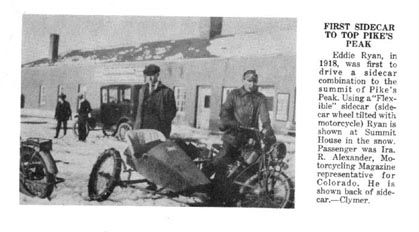
Flxible started business making motorcycle side
cars that leaned (or flexed) as the cycle rounded corners. A common
word cannot be copyrighted so they dropped the "e" hence Flxible.
Most Bus body builders obtain chassis from GM and
other truck manufacturers and install thier bodies on them. Flxible
was a bit more "In House" and used GM parts exclusively.
This is how the Flxible is related to GM:
FLXIBLE COMPANY was incorporated in Loudonville, Ohio, April 9th 1914.
Its first President was Charles F. Kettering. Kettering joined GM in 1916
and the two companies became interlocked. Kettering was a Vice-President,
Director and Shareholder of GM from 1929 to 1958. He was President of Flxible
from 1915 to 1940, Chairman of the Board 1940 to 1958, Director 1915 to
1958 and the largest individual stockholder, 1915 to 1958.
No wonder Flx used far more Chevrolet parts
in their bus body, compared to other bus body makers. This relation
ship is similar to that of Fisher with GM.
For a little bit of history, In 1936, the Flxible Airway had a hood and front fenders like school busses. For 37 the engine was still up front but the driver and one passenger sat next to the engine. This was a transitional year. By 38 the Flxible Clipper was a pusher with rear engine and remained so till the halt of Clipper model in the sixties. They were available with Chevy or Buick engines but the drive train was larger truck than Chevrolet after 1938. Most of the Muni busses you see today are Flxibles with Z drive and transverse rear diesel engine.
Total Vanity!
(ambulance in background in photo below).
The Radiator cap on Flx is same as gas cap on Canopies and head light buckets were also stock Chevy truck.
There were Two 38 Gallon gas tanks on either side with a "T" into fuel pump. No switch. Note also that the rear emergency door is located in front of the rear wheel whose center is 9' ahead of taillight. Some Designer felt it necessary to disrupt the rear sweep of the roof with a ladder and recessed roof rack. Not easily seen in this photo is one measly oval 37 truck taillight that could only be seen on a very dark night.
.
The driver has the most uncomfortable seat in the
house (bus). The Ross (iH) steering wheel is a foot to the right
of the driver. I frequently hit the brake when I'm headed for the
gas. The brakes are the unsafe AIR/Hydraulic. I upgraded the
system to dual master cylinder with warning light. The rear axle
is stock 37 Chevy with 16" X 3" brake drums. The front axle uses
Chevy wheel cylinder and Huck brakes but its 16" X 2 1/2" on a Timken axle.
The gauges (pictured below) are same as in 37 trux with the addition of
6 volt meter and air pressure. It has a little Chevy electrical beep
by radiator and Air Horn Blaster under clutch pedal. The shift lever
was sawed off the trans and bolted on the manifold where the horn or rectifier
was originally located.
Here's the diminutive 216 Chevy engine. Changing
points is a tight squeeze. It has a 6 volt alternator and two
6 volt batteries in parallel. The air cleaner is unique to
the Flx.
There are 3 heaters on this bus. Amazingly this heater by the front door (shown below) and the one under rear seat, work. The one next to driver (shown above) has froze motor.
.
No one has to stand on this bus!
They can flip down the aisle seats. Trouble is, when someone in back
wants to get off, everyone in the aisle seats has to get up and fold the
seats. Guess what happens when someone yells, "FIRE!!". (Remember
where the emergency door is located?) Passenger
seats reclined with head rest like airline seats of today. (no movie in
flight though). All seats, that is, except the driver who has fixed
seat w/o headrest.
The window winders below are also from the GM
parts bin.
.
On the seat frame (right above) you can barely read
Flxible Clipper. That predates the Packard's Clipper by 4 years.
My bus was mechanically sound so after brake work, I had to take it
for a spin. On my maiden voyage, the canopy followed to pickup the
rotten wooden parts that fell off. I need to do a lot of work in
the body before it drives again.
Dealer Brochure for Flxible:
I was fortunate enough to received
some literature on the Flxible Clipper. Let me pass it
on to you below with the usual commentary.
In the artist concept drawing to the
right, notice that there are more than 4 stainless strips decorating the
front and side of the Flx.
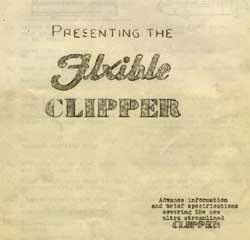
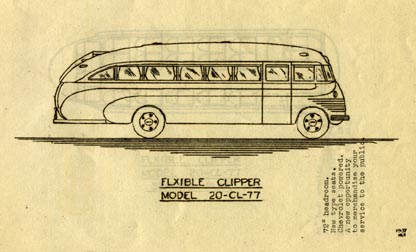
In #4, the Flx brakes are actually Air over Hydraulic.
In picture to the right, the seat behind the driver faces foward
but has the batteries under it.


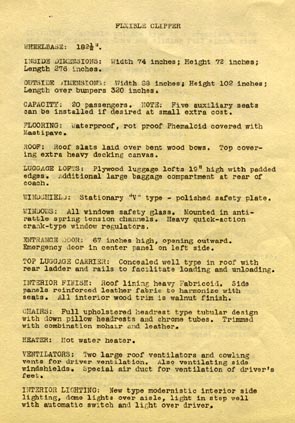

In the section on Rear Axle below, Note you could order a 4.75 rearend. with 7.50 X 20 tires, the Flx would rev at 2737 RPM at 60 MPH. If a driver could find a long enough straight road in 1937, they could really step on down the road.
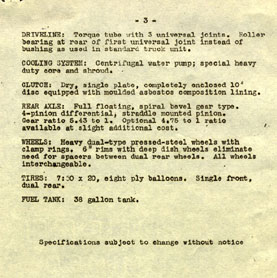
Click on this 1940 Chev/Wayne
to view other busses.
Click Fitzjohn to view Limousines.
.
Sorry, Still under construction!!![]()
The Flxible
owners international club web site is <http://flxibleowners.org/>.
The Pacific
Bus Museum, another Bus club is located at <http://www.pacbus.org/>.
Please bookmark this site as there is no return link.
Link to another
Bus site. Please bookmark as there is not a return link.
Click here for Taxi, Limousine,
and Airport Busses >>
Check out the Bus
page >>
Back to Trux>>
Back Home>>>
"GM Futurliner" Another
GM inline 6 powered blimp. Please bookmark as there is not a return
link.
Click
here if you came in from the Stove bolt page, and wish to return
<http://www.stovebolt.com/truck/gallery.htm>.
>>

Repair tips
Coach
Touring
Taxis and limousines
Sedan Delivery
Coupe Pickup
Coupe
Sedan
Bus
Station Wagons
Back to carz >>
View trux >>
Back Home >>>